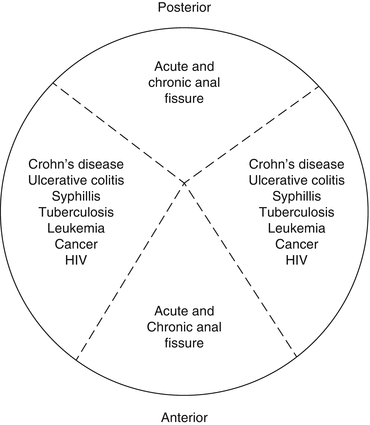Fig. 12.1
Examination revealing an anal fissure
The differential diagnosis includes perianal abscess, anal fistula, inflammatory bowel disease, a sexually transmitted disease, and anal carcinoma.
Atypical fissures (off the midline, multiple, painless, and nonhealing fissures) warrant further evaluation with an exam under anesthesia, possible biopsy, and culture. Figure 12.2 illustrates the location of the anal fissure correlated with possible etiologies of the fissure.


Fig. 12.2
The location of anal fissure suggests etiology
Management
Fifty percent of acute fissures heal with sitz baths, psyllium, and topical anesthetics or anti-inflammatory ointments. Eighteen to twenty-seven percent recur within 5 years.
Sphincter Relaxants
Many agents to reduce mean and maximum anal resting pressure have been tested.
Many of the topical preparations are only available through compounding pharmacies. Clinicians should be familiar with their available pharmaceutical resources before recommending a medical treatment that requires compounding.
Topical Nitrates
The internal sphincter is a smooth muscle and topical nitrates relax smooth muscle to theoretically improve blood flow to the fissure and promote healing.
Initial healing rates were encouraging with the use of topical 0.2 % nitrates (nitroglycerin cream). Headaches and problems with patient compliance following the planned treatment regiment were a problem with this therapy.
Sustained healing of anal fissures has not been optimal, and combined with adverse reactions such as headaches (and some reports of orthostatic hypotension) has limited the use of topical nitrates.
Calcium Channel Blockers
Calcium channel blockers can be administered in an oral form (as 20 mg oral or sublingual nifedipine) or topically (2 % diltiazem gel) to treat anal fissures. There have not been sufficient studies with large enough numbers comparing oral versus topical therapy to give a definitive conclusion as to superiority of one delivery method over the other.
From several randomized studies, it appears that topical calcium channel blockers have at least similar healing potential compared to topical nitroglycerin with fewer side effects. This has led some authors to conclude that calcium channel blockers should be the first line of treatment.
Topical calcium channel blockers compared to lateral internal sphincterotomy showed fewer relapses with surgery. Studies comparing these two types of treatment for initial fissure healing, pain relief, and compliance show conflicting results.
There are few long-term studies looking at sustained healing rates for calcium channel blockers. Therefore, definitive assessment of long-term healing is not possible.
Adrenergic Antagonists
Despite reduction of anal sphincter resting pressures, (limited) studies have failed to demonstrate that oral administration of alpha-1 adrenergic blockers will heal fissures.
Cholinergic Agonists
0.1 % bethanechol gel reduces maximal anal resting pressures and has been shown to heal anal fissures in one limited study.
Phosphodiesterase Inhibitors
Topical administration of a phosphodiesterase-5 inhibitor (sildenafil) was shown to significantly reduce anal sphincter pressures in one study. Whether this effect will lead to sustained healing of anal fissures has yet to be demonstrated.
Botulinum Toxin
Botulinum toxin is an exotoxin that, when locally injected, binds to presynaptic nerve terminals of the neuromuscular junction preventing release of acetylcholine and temporarily paralyzing the muscle. Studies have shown that the predominant effect on the internal sphincter is through sympathetic blockade.
Authors report that this treatment can be easily injected/administered in the outpatient setting and is well tolerated.
After evaluation of multiple studies focusing on the optimal dose and injection site of botulinum toxin, it appears that 20 units injected on either side of the anterior midline in the intersphincteric groove provides the best results.
Comparative studies of botulinum toxin versus topical nitroglycerin showed conflicting results as to healing.
Stay updated, free articles. Join our Telegram channel

Full access? Get Clinical Tree






